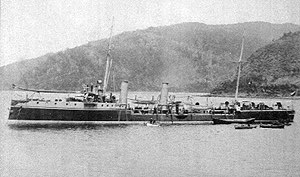
In naval terminology, a destroyer is a fast, maneuverable, long-endurance warship intended to escort larger vessels in a fleet, convoy, or carrier battle group and defend them against a wide range of general threats. They were originally conceived in 1885 by Fernando Villaamil for the Spanish Navy as a defense against torpedo boats, and by the time of the Russo-Japanese War in 1904, these "torpedo boat destroyers" (TBDs) were "large, swift, and powerfully armed torpedo boats designed to destroy other torpedo boats". Although the term "destroyer" had been used interchangeably with "TBD" and "torpedo boat destroyer" by navies since 1892, the term "torpedo boat destroyer" had been generally shortened to simply "destroyer" by nearly all navies by the First World War.

A torpedo boat is a relatively small and fast naval ship designed to carry torpedoes into battle. The first designs were steam-powered craft dedicated to ramming enemy ships with explosive spar torpedoes. Later evolutions launched variants of self-propelled Whitehead torpedoes.

The Chilean Civil War of 1891 was a civil war in Chile fought between forces supporting Congress and forces supporting the President, José Manuel Balmaceda from 16 January 1891 to 18 September 1891. The war saw a confrontation between the Chilean Army and the Chilean Navy, siding with the president and the congress, respectively. This conflict ended with the defeat of the Chilean Army and the presidential forces, and with President Balmaceda committing suicide as a consequence of the defeat. In Chilean historiography the war marks the end of the Liberal Republic and the beginning of the Parliamentary Era.

Robert Whitehead was an English engineer who was most famous for developing the first effective self-propelled naval torpedo.

In late 19th-century naval terminology, torpedo gunboats were a form of gunboat armed with torpedoes and designed for hunting and destroying smaller torpedo boats. By the end of the 1890s torpedo gunboats were superseded by their more successful contemporaries, the torpedo boat destroyers.

The Faulknor class were a class of flotilla leaders that were under construction in the United Kingdom for the Chilean Navy at the outbreak of World War I. Six ships were ordered by Chile, of which the first two were delivered to Chile before the outbreak of the war. The remaining four ships were purchased by the British, taken over and completed for the Royal Navy for wartime service. In common with Royal Navy convention, they were named after famous Royal Navy captains of the past, in this case the members of the Faulknor family.
Several ships of the Chilean Navy have been named Almirante Condell after Admiral Carlos Condell (1846–1912), hero of the Battle of Punta Gruesa during the War of the Pacific:
Several ships of the Chilean Navy have been named Almirante Lynch after Patricio Lynch (1824–1886), a Chilean hero during the War of the Pacific

The Almirante Lynch class were a group of destroyers built for the Chilean Navy prior to World War I. Initially six ships were planned, two being delivered. The other four were purchased by and incorporated into the Royal Navy during World War I as the Faulknor class. Following the war, the three surviving ships were returned to the Chilean Navy and renamed the Almirante Williams class. The class of ships was named after Admiral Patricio Lynch, Chilean sailor, hero of the War of the Pacific.
Several ships of the Chilean Navy have been named Blanco Encalada after Manuel Blanco Encalada (1790–1876), a Vice Admiral and Chile's first President

Two Daring-class destroyers were the very first torpedo boat destroyers ("TBDs") to be ordered for the Royal Navy, the order being placed on 27 June 1892.
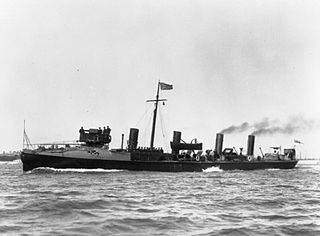
Two Ferret-class destroyers served with the Royal Navy. Ferret and Lynx were built by Laird, displaced 280 tons and were 199 feet (61 m) in overall length.

Almirante Cochrane was a central battery ship of the Chilean Navy in the late nineteenth century. She was built, like her twin, Blanco Encalada, in the UK in 1875. She participated in the War of the Pacific, with her most prominent action being her victory over the Peruvian turret ram Huáscar in the Angamos naval battle. Almirante Cochrane was part of the forces that defeated President José Manuel Balmaceda in the Chilean Civil War of 1891.
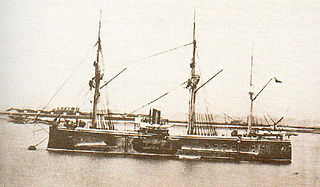
Blanco Encalada was a central battery ship built by Earle's Shipbuilding Co. in England for the Chilean Navy in 1875. She was nicknamed El Blanco. She participated actively in the War of the Pacific, her most important action being the capture of the Peruvian monitor Huáscar during the Battle of Angamos.

The Battle of Caldera Bay, or the Sinking of Blanco Encalada, was a naval engagement fought in the Caldera Bay during the 1891 Chilean Civil War between Balmacedist and Congressional naval forces on 23 April 1891. It involved two Balmacedist torpedo boats of the Almirante Lynch-class, and the Congressional armored frigate Blanco Encalada.
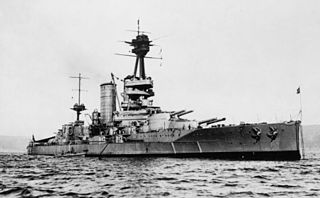
The Almirante Latorre class consisted of two super-dreadnought battleships designed by the British company Armstrong Whitworth for the Chilean Navy. They were intended to be Chile's entries to the South American dreadnought race, but both were purchased by the Royal Navy prior to completion for use in the First World War. Only one, Almirante Latorre (HMS Canada), was finished as a battleship; Almirante Cochrane (HMS Eagle), was converted to an aircraft carrier. Under their Chilean names, they honored Admirals (Almirantes) Juan José Latorre and Thomas Cochrane; they took their British names from what was then a dominion of Canada and a traditional ship name in the Royal Navy.

A torpedo cruiser is a type of warship that is armed primarily with torpedoes. The major navies began building torpedo cruisers shortly after the invention of the locomotive Whitehead torpedo in the 1860s. The development of the torpedo gave rise to the Jeune École doctrine, which held that small warships armed with torpedoes could effectively and cheaply defeat much larger battleships. Torpedo cruisers fell out of favor in most of the great power navies in the 1890s, though many other navies continued to acquire them into the early 1900s.

The Almirante Lynch class was a pair of two torpedo gunboats, Almirante Lynch and Almirante Condell, ordered for the Chilean Navy in the late 1880s.
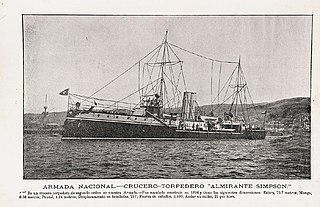
Almirante Simpson was a unique design of torpedo gunboat, built by the British shipyard Laird Brothers. Acquired by the Chilean Navy in 1895, during construction. The ship had a brief service in Chile, being transferred to the Ecuadorian Navy in 1907 and renamed Libertador Bolívar. She was the first Ecuadorian warship of the 20th century and had an important participation in the Ecuadorian Civil War of 1913–1916. After the war, the ship was retired and then sank in 1928.

The Pilcomayo was a gunboat of the Peruvian Navy which was involved in several actions during the War of the Pacific. Captured by the Chilean Navy on November 18, 1879, she was repaired and participated in the blockade of the Peruvian ports. After the war it was used for hydrographic research, then as a training ship. In service until 1909, Pilcomayo was finally used as a pontoon at Talcahuano.
